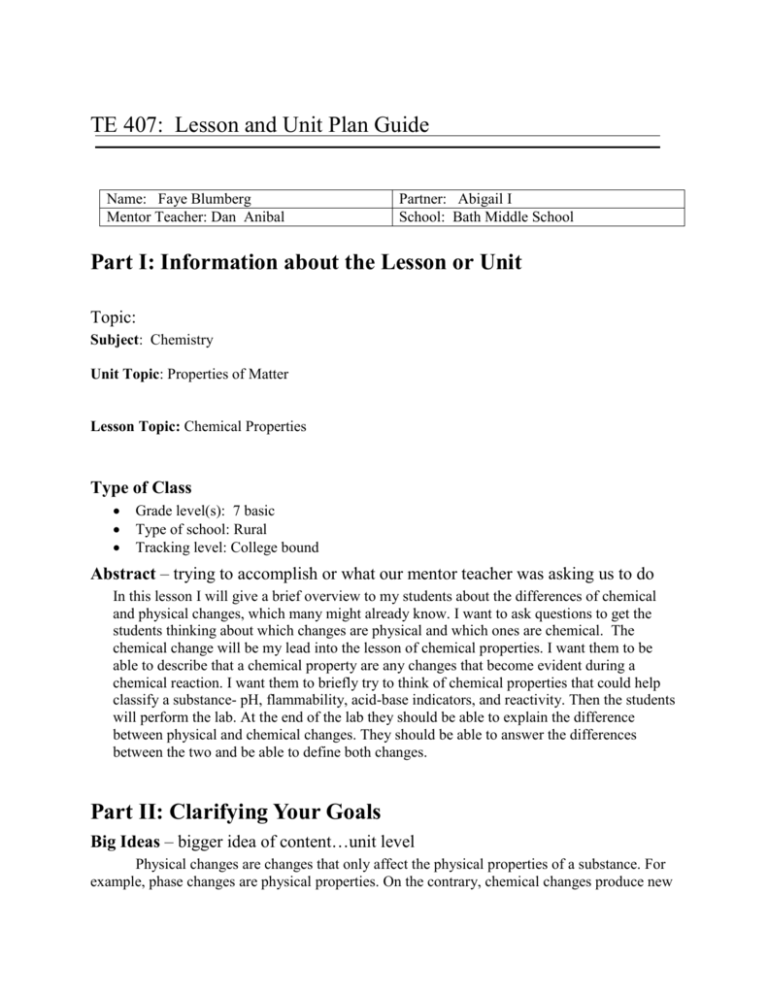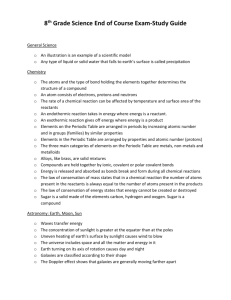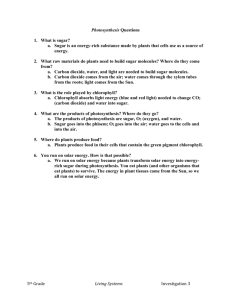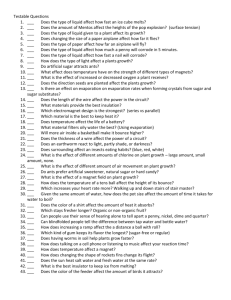Chemical Properties - Michigan State University
advertisement

TE 407: Lesson and Unit Plan Guide Name: Faye Blumberg Mentor Teacher: Dan Anibal Partner: Abigail I School: Bath Middle School Part I: Information about the Lesson or Unit Topic: Subject: Chemistry Unit Topic: Properties of Matter Lesson Topic: Chemical Properties Type of Class Grade level(s): 7 basic Type of school: Rural Tracking level: College bound Abstract – trying to accomplish or what our mentor teacher was asking us to do In this lesson I will give a brief overview to my students about the differences of chemical and physical changes, which many might already know. I want to ask questions to get the students thinking about which changes are physical and which ones are chemical. The chemical change will be my lead into the lesson of chemical properties. I want them to be able to describe that a chemical property are any changes that become evident during a chemical reaction. I want them to briefly try to think of chemical properties that could help classify a substance- pH, flammability, acid-base indicators, and reactivity. Then the students will perform the lab. At the end of the lab they should be able to explain the difference between physical and chemical changes. They should be able to answer the differences between the two and be able to define both changes. Part II: Clarifying Your Goals Big Ideas – bigger idea of content…unit level Physical changes are changes that only affect the physical properties of a substance. For example, phase changes are physical properties. On the contrary, chemical changes produce new substances, which have different properties, compared to the old substances. The composition is a chemical change is altered. This occurs when you burn a substance, mixing an acid and a base, or when you observe rusting or rotting. The process that produces a chemical change is known as a chemical reaction. A chemical reaction is composed of reactants and products. Many chemical reactions are irreversible. The chemical reaction only goes one way. There are many ways to recognize a chemical change. The substance may produce bubbles (gas), change color, have an odor, produce a precipitate, or absorb/release energy. However, there are always exceptions to these generalizations. Energy is needed in many chemical changes in order to break bonds. Atoms in a chemical process are never lost but instead are rearranged. Chemical processes can be tested on a daily bases. How flammable is sand? How about sugar? What about salt? Understanding chemical properties can help explain how new substances are formed. We can classify substances by their chemical properties. We can measure pH, flammability, reactivity (against other chemicals), electronegativity etc. We can also use acid-base indicators to titrate substances and observe when they have been neutralized. On the contrary, there are also physical properties. These properties can be seen or measured with out changing the composition. Such examples may be absorption, density, length, mass, etc. These properties can be determined with out changing the composition of the substance. Experiences, Patterns, and Explanations Observations or experiences (examples, phenomena, data) Patterns (laws, generalizations, graphs, tables, categories) Explanations (models, theories) Incoming Ideas Chemical changesburning, rotting, chemical reactions, photosynthesis Physical changescutting, boiling, cooling, changing pressure, changing states Dissolving?- students may not know how to classify dissolving changing from solid to liquid to gas (phase changes) are just physical changes sugar dissolves we can still get the sugar back if we dissolve all the water crushing the sugar or dissolving the sugar wont change its taste crushing the sugar wont change its chemical makeup Chemical changes are from chemical reactions – new substances are formed Chemical changes may look different, have a different smell, or color. Goal/Target EPEs Physical changes can usually go in reverse- energy may be needed Chemical changes are separate changes in substances (misconception) Physical changes only effect physical properties heating the sugar creates a chemical changethe sugar is burnt and changes color the burnt sugar produces a certain odor Chemical changes usually can’t be undone (or go in reverse) Chemical changes are just rearrangements of atoms. Atoms are not created or destroyed. often can detect a chemical change by a change in color/odor/ph/precipitation In a chemical change a new substance is usually formed The arrangement of atoms is through breaking or making bonds. Application: Model-based Reasoning – using models/theories to explain experiences Inquiry: Finding and Explaining Patterns in Experience Objectives for Student Learning Michigan Objective(s) 1. P.PM.07.11 Classify substances by their chemical properties (flammability, pH, acid-base indicators, reactivity). 2. P.CM.07.22 Compare and contrast the chemical properties of a new substance with the original after a chemical change Specific Lesson Objective(s) 1. When did the sugar go through a physical change? What properties remained the same and what changed? When did the sugar go through a chemical change? How do we know? 2. Be able to discuss which changes are usually irreversible and which are reversible. How could we get the sugar back to its original form after crushing it? How about after dissolving it? Burning it? Problem: Ask the students what is occurring when a marshmallow burns. Demonstrate Model: Ask what kind of change is occurring when something burns in general. What changes with the substance? Give them the example of a metal rusting and help guide them through what happens. Coach- Ask questions regarding chemical and physical changes. How can we tell the difference? Is one reversible? Give a brief overview of the lab and be ready to answer any questions Fade- Have the students reform the lab Part III: Classroom Activities Materials Each group will also get the lab write up, “Observing Changes in Matter.” Presentation materials : Since my students are watching a demo and doing a lab I don’t want to take too much time doing presentation (a powerpoint etc). I will however explain things slowly through lecture give examples and ask for any questions. I think this objective is learned best hands on. Copied materials (Handouts, worksheets, tests, lab directions, etc.): I have copies of the labs but have no scanner. I copied them from Mr. Anibal before I left school today- I can get you these in person Pages in textbook: Book: Glencoe Science- Chemistry, National Geographic Pages: 36-38 Laboratory materials: For the teacher or the class as a whole: Marshmallow and a match For each laboratory station: Each group will need the following: 4 cubes of sugar Glass of water Spoon Mortar & pestle Bunsen burner Test tube Tongs Activities Introduction (7-10 minutes) • Make conceptual connections with previous lessons- From what Mr. Anibal has said, this is their first intro into physical and chemical changes. We’re using this lab as a guide to further discuss chemical properties of a substance. This is more so the gateway into the objective gave me. I want to ask the students what they know about physical and chemical changes. How can we tell which is occurring? Can you give examples of each? Which are reversible? I want to discuss the ways we can classify chemical reactions through their chemical processes. How flammable is a substance?? Does a substance dissolve in water? The students should be able to explain and connect the fact that you can classify substances by their chemical properties and have them provide examples (maybe not after this intro lab, but that is the “bigger goal”) To get them started about thinking on the right track I plan on show a demonstration. The marshmallow will burn. This will spark their interest (hopefully) and get them engaged on the lesson. I’d then introduce the lab to the students and go through what they will be doing briefly. I also want to warn them not to swallow the burnt sugar, but may taste it. They should also be very careful while using the burner. Glass will not look hot. Main Teaching Activities 20-25 min) The main activity is having the students performing the lab. They first crush up sugar and see that it still has the same properties. They then put sugar in water watch it dissolve and explain what is occurring. After, they have the sugar go through a chemical change by burning it. Through out the lab they are using their senses to see, taste, touch the sugar in all forms. They will look at the size, shape, color, hardness, and texture to see how it changes depending on the physical or chemical change. The students will be performing the lab. The lab is pretty self-explanatory and has key questions to answer throughout. I will be walking around, answering any questions, as well as giving safety cautions. The student’s references materials are basically each other, the lab, and myself. The lab walks them through key questions to think about and the conclusions to draw. Conclusion (7-10 minutes) After the students have finished performing the lab, they should clean up and get their lab area in order. After, I want the students to regroup and as a class discuss the lab. I want to engage a discussion of what the students learned about classifying substances based on chemical properties. There are two critical thinking questions at the end of the lab. Having students answer these questions can be helpful to see which students got the “big ideas.” With that being said I don’t want to give too much of the answers away by a discussion. I want to lead the students on the right track but still having them draw their own conclusions about chemical changes, physical changes, and chemical processes. Part IV: Assessment of Students Developing Assessment Tasks The major assessment for my lesson is the lab worksheets they complete and the lessons they answer. There are questions that are embedded throughout the lab as well as questions to answer after the lab has been completed. There are many questions that the students cannot get wrong. These are questions about what is occurring in the lab. How has the sugar changed? (asked after the physical AND chemical change) Is the sugar still present? How are the physical and chemical changes different? How would you classify a physical change? What about a chemical change? I want to discuss and ask a question also about chemical processes, however I still need time to think about questions that they’ll be able to answer after performing this lab. I think I’ll learn from incorrect answers. By seeing what they were confused on, I can revamp my next lesson to clear up any misconceptions. I think if students don’t understand the science behind chemical and physical changes, they wont really understand the concept. Knowing that chemical reactions produce a chemical change is pretty important. Its also very important that the students understand that atoms are not created or destroyed. The atoms and molecules are rearranged. This idea can later build by looking at reactions, rates, precipitates, etc. The task is relevant to the objective in the sense that it’s a gateway to learning about chemical processes. In order to be able to explain chemical processes, students must first be able to explain chemical changes. The chemical change concepts will then help the students make connections to chemical properties, i.e. The sugar melted, that means it has a chemical property of flammability. The lab the students are performing is very clear-cut. It has the students answer questions and go through the lab step by step. It’s a very good walk through about how the students can differentiate physical and chemical changes. The theory questions at the end of the lab have students relate the lab to patterns they should have picked up through out the lab. Compare the changes in the sugar. How are they different? How do you define a physical change? How would you define a chemical change? With the answers to these questions I can see what concepts they picked up on. The only thing I’m worried about is the fact the students may not really understand physical/chemical changes, but just write down what they remember from my intro and class discussion. I think this will have to be determined on an individual basses and after the lab has been preformed.






